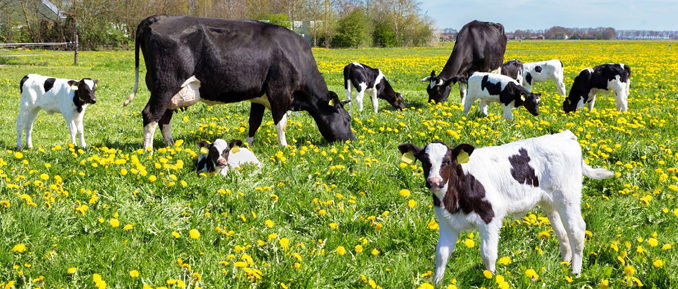
If you are familiar with cattle, you may be aware of the dangers heat poses to these sensitive creatures. They have a lower tolerance for heat than humans do, and if their bodies become too warm, they can experience changes that are neither beneficial for farmers and consumers, nor for the animals themselves. Temperature, precipitation, humidity, wind, and amount of direct sunlight are all main factors in determining an animal’s body temperature. If these variables are not monitored properly, cattle can experience heat stress, and the effects will be damaging.
In dairy cattle, heat stress is a major issue in milk production loss. Rising global temperatures and record high heat waves can cost the dairy industry billions in milk and animal losses each year. Not only are the cows negatively impacted, but calves born to pregnant dams exposed to heat stress are also affected….and for years later with reduced immune functioning, metabolism, and milk production. Why this occurs and the underlying mechanisms responsible for this phenotypic result have yet to be elucidated.
Scientists at the University of Florida, however, may be able to shed some light on this occurrence in their recent study published in Scientific Reports. Considering how early life environment can epigenetically impact development, the team sought to determine if in utero heat stress causes alterations in phenotype via changes in DNA methylation. Their investigation looked at key regulatory gene pathways in the liver and mammary gland of bull calves and heifers that were maternally exposed to environmental heat stress during late gestation.
Late gestation is a crucial time period for developing cattle offspring. Muscle growth and fat deposition are increased, leading to quickness in fetal weight gain. If the mother is exposed to high ambient temperature during this time, her calves end up being shorter and lighter at birth, and this can last all the way through puberty. Fetal organs also experience functional maturation during late gestation, which prepares the developing fetus to sustain life after it is born. If a mother is subjected to heat stress during this critical period, her calves display modifications in energy metabolism and reproductive physiology, which is linked to mammary gland development. The calves also display modifications in energy metabolism and have higher morbidity associated with depressed immune competence, both of which are linked to liver development.
Such affronts can be attributed to DNA methylation, an epigenetic mechanism that adds a methyl group to cytosine at the 5’ position by DNA methyltransferase, forming 5-methylcytosine (5-mC). Genes can be turned on and off through this mechanism, which is why DNA methylation is considered an important epigenetic mark for genomic stability and for maintaining proper development. In previous articles, we have discussed how changes in temperature, such as global warming and extreme cold can affect DNA methylation causing cellular alterations. We also reviewed how prenatal maternal stress predicts the amount of DNA methylation in offspring.
The liver and mammary gland, in particular, are known to be regulated by epigenetic mechanisms and may be altered under heat stress. Research has shown that DNA methylation is involved in milk synthesis. In addition, this mechanism also plays a role in liver cell differentiation and proliferation. Here, the current study’s aim was to first examine late gestation fetal exposure to heat stress in the liver and mammary gland and then characterize the DNA methylation changes and gene expression observed in phenotypic outcomes.
Collecting tissue samples from both cooled and heat stressed pregnant cows, as well as from their offspring, the research team was able to identify roughly 400 differentially methylated genes (DMGs) that play a role in processes such as development, innate immune defense, cell signaling, and transcription and translation. They also identified over 100 similar functioning differentially expressed genes (DEGs).
While the study did have some limitations, including a high culling rate and 2-year delay on mammary tissue collection, the substantial number of DMGs and DEGs found suggests that these marks may be linked to the observed morphological differences that were shown in the liver and mammary gland of the calves.
More research is needed to elaborate upon these findings and perhaps investigating other epigenetic mechanisms could give further insight. As the authors noted, “It is also possible that heat-induced changes in DNA methylation may not play a significant regulatory role in gene expression. Rather, heat stress may alter gene expression through other epigenetic modifications, such as histone modifications, chromatin remodeling, or microRNAs.”
For now, detecting heat stress early in cattle and implementing strategies to minimize its effects are necessary farming practices. But some heat stress is unavoidable and most cattle cannot adapt quickly enough to fluctuations in temperature. It’s predicted that climate change will affect livestock production and consequently food security. Hopefully, epigenetic studies like this could pave the way for future research into cattle breeding practices that mitigate losses from heat stress as well as diseases and other environmental factors.
Source: Skibiel AL et. al. (October 2018). In Utero Heat Stress Alters the Offspring Epigenome. Sci Rep. 8(1):14609.

